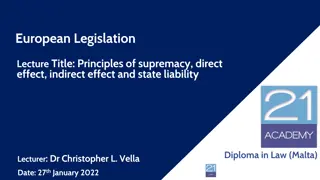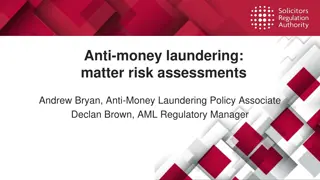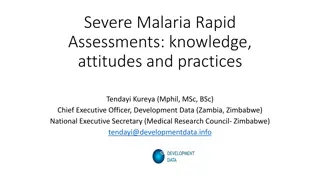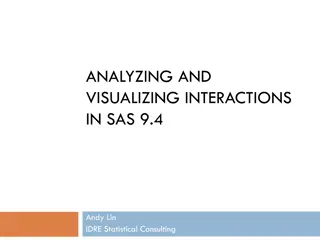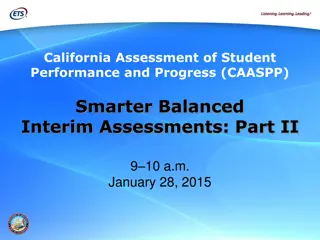Understanding the In-Combination Effect Test and De Minimis Effects in Environmental Assessments
This content discusses the complexities of the in-combination effect test and de minimis effects in environmental impact assessments. It covers when the in-combination effect assessment is needed, the legislation surrounding such assessments, and the concept of no appreciable effect as a threshold for exclusion from assessments.
- Environmental assessments
- In-combination effect test
- De minimis effects
- Legislation
- No appreciable effect
Download Presentation

Please find below an Image/Link to download the presentation.
The content on the website is provided AS IS for your information and personal use only. It may not be sold, licensed, or shared on other websites without obtaining consent from the author. Download presentation by click this link. If you encounter any issues during the download, it is possible that the publisher has removed the file from their server.
E N D
Presentation Transcript
The in combination effect test and de minimis effects Penny Simpson Wednesday, 4 March 2020
The issue The in combination effect test The trickiest HRA issue When does it apply / can it be avoided? Is it possible to set de minimis thresholds (eg for Nitrogen dep) to exclude certain activities from HRA?
The legislation Stage 1 Screening: no likely significant effect on a European site from plan or project alone or in combination with other plans or projects Stage 2: no adverse effect on the integrity of a European site [alone or in combination with other plans or projects] (European Court Waddenzee, para 53)
The legislation Legislation talks about effects Not about impact pathway points eg nos of walkers / molecules of N dep / increase in Annual Average Daily Traffic (AADT) It s a key distinction When do pathway points become effects?
When is the in combination effect assessment needed? Stage 1 Screening: Effect of plan / project on European site (no mitigation measures may be taken into account) In combination assessment required? 1. Positive effect 2. Neutral effect / Zero pathway points 3. No appreciable effect ( nugatory / indistinguishable from background variations ) 4. De minimis effect (adverse) 5. Risk of (adverse) significant effect 6. Significant (adverse) effect No No No Yes No No
No appreciable effect (1) Advocate General Eleanor Sharpston in Sweetman C-258/11 para 48: The requirement that the effect in question be significant lays down a de minimis threshold Plans or projects that have no appreciable effect on the site are thereby excluded If all plans or projects capable of having any effect whatsoever on the site were. caught.....activities would risk being impossible by reason of legislative overkill No appreciable effect = no in combination assessment needed
No appreciable effect (2) NE s AQ / traffic guidance June 2018: no in combination assessment needed where no appreciable effect (para 4.47 and 5.69) no appreciable effect means an inconsequential effect (para 5.69)
But does this work? A few pathway points could still combine? (1) Advocate General wants to avoid legislative overkill Domestic case law agrees: Newry Chamber of Commerce and Trade's Application for Judicial Review [2015] NIQB 65 (paragraphs 51-63): at no stage did the applicant put forward credible evidence that there was real rather than hypothetical risk [of an in combination effect] which should have been taken into account as a result of the matters including the 18km distance involved it is considered that there will be no adverse effects on the SPA. The development will not therefore contribute to any in combination effects with other developments
But does this work? A few pathway points could still combine? (2) Secretary of State planning decisions dated 1 March 2018 from Mid Sussex Increases in traffic flow along roads within the Ashdown Forest SAC / SPA The SoS sought advice from NE the increased Annual Average Daily Traffic expected from this proposal considered ..to be nugatory and indistinguishable from background variations . so no LSE on the Ashdown Forest SAC and SPA, either alone or in combination with other plans or projects a full AA is not needed .
But does this work? A few pathway points could still combine? (3) Herefordshire Council position statement 2019 on diffuse pollution from drainage to the River Lugg (River Wye SAC): If a certain distance from river, no need to consider phosphate run-off My own clients projects Recreational impacts: Project will lead to 0.05% increase compared with existing visitor numbers Air quality impacts AADT of 32 from the project alone
NEs nutrient neutrality policies But .. NE s nutrient neutrality policies do not reflect this eg in the Solent Region eg the River Wye SAC in Herefordshire Every molecule counts / there must be neutrality in pathway points Can this be justified?
De minimis effects (1) Wealden DC v Secretary of State [2017] EWHC 351: de minimis is not a synonym for nugatory An effect which is more than not appreciable / more than inconsequential These do trigger an in-combination assessment
De minimis effects (2) Wealden District Council v SoS, 20 March 2017: Judge considered Design Manual for Roads and Bridges Vol 11 Sets a HRA screening threshold of 1000 AADT for a project s / plan s road traffic within 200m of a European site Threshold must be applied to combined effects ie Lewes / South Downs National Park Joint Core Strategy (190 AADT) and Wealden DC Core Strategy (950 AADT) must be combined
De minimis effects (3) This approach is adopted in NE s AQ guidance 2018: what is the AADT from your plan or project (unless no appreciable effect ) identify other in combination plans / projects combine their AADT increases then apply the 1000 AADT threshold
Identifying other in combination plans / projects (1) Proportionality / practicality is relevant EC parliamentary question 2005: take into account the practical feasibility of making an assessment of combined effects the combination provision must be applied in a manner which is proportionate to the timing, planning stage and legality of the proposed plans and projects
Identifying other in combination plans / projects (2) Walton and Others v The Scottish Ministers [2011] CSOH 131 Aberdeen Western Peripheral Route Claim that the AA had failed to consider properly the in combination effects: [decision makers] entitled to exercise judgment as to the [in combination] projects . . there must be a degree of flexibility in assessing the projects with which a particular proposal should be regarded as having an in combination affect .
Setting AQ de minimis thresholds for future plans or projects (1) Wealden judge envisaged setting thresholds for future plans / projects para 53 Competent authorities are quite entitled to use threshold levels .. in order to eliminate from further consideration de minimis environmental impacts which, on scientific evidence, fall short of engendering any relevant risk .. Judge gave the example of 20 AADT But this would need to be accompanied by justification: para 95 ..if .specific impacts are very low indeed these can properly be ignored eg if each AADT were known to be 20, it would require 50 of these to attain the [1000 AADT] threshold... [which is] inherently unlikely
Setting AQ de minimis thresholds for future plans or projects (2) The Dutch nitrogen cases are in line with Wealden The Dutch PAS system included N deposition thresholds under which no authorisation for activities was needed: Project causing nitrogen dep of <0.05 mol N/ha/yr = no authorisation needed Projects causing nitrogen dep of >0.05 mol N/ha/yr - <1 mol N/ha/yr = no authorisation needed, but the applicant must still notify the authorities
Setting AQ de minimis thresholds for future plans or projects (3) European Court: supported the possibility of thresholds but threshold must be supported by an AA carried out in advance looking at the plans / projects under the threshold showing that, based on the chosen threshold, there will be no reasonable scientific doubt as to absence of adverse effect of those plans or projects on site integrity
Conclusions It s complex Pathway points don t need a HRA / in combination assessment if no appreciable effect I think so If de minimis effects, need to do an in combination assessment Good luck working out the technical difference! AQ HRA threshold is possible if there is a AA which shows it will secure no adverse effect
Contact Penny Simpson Partner T: 0845 017 1133 M: 07918 767811 E: penny.simpson@freeths.co.uk










